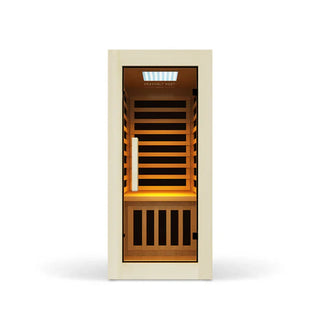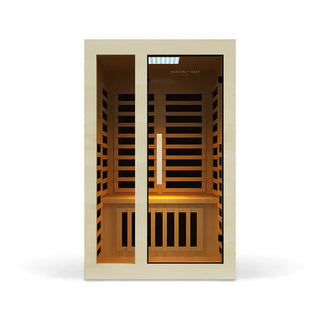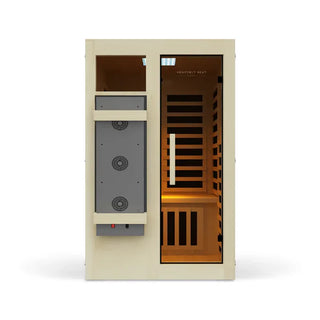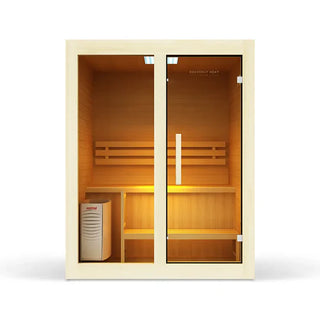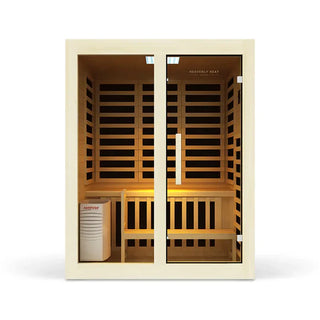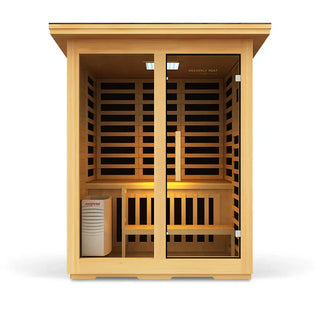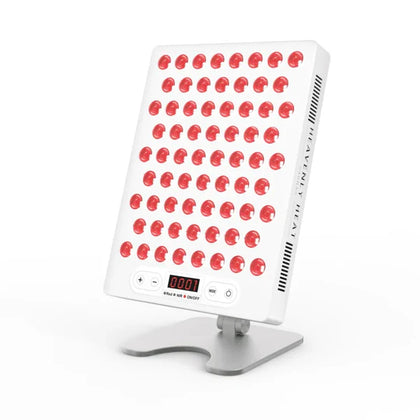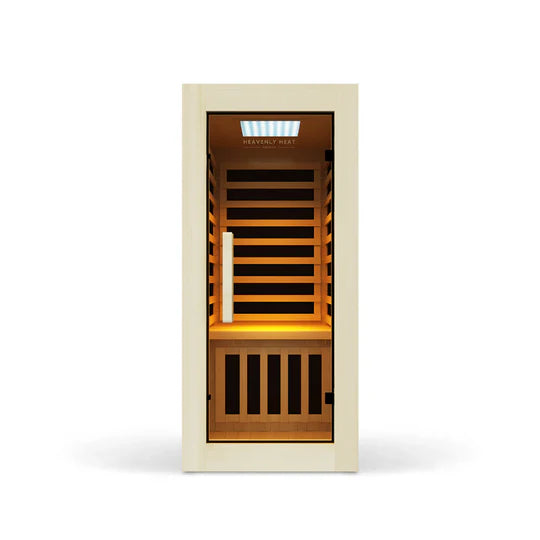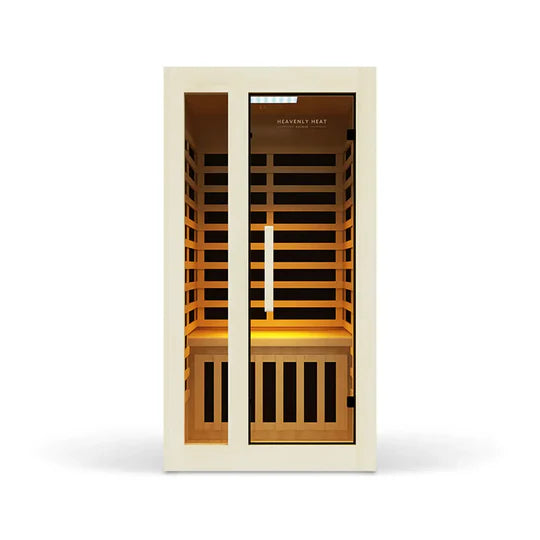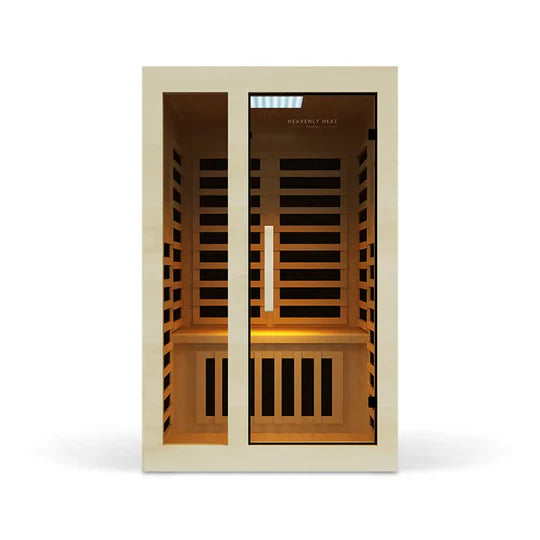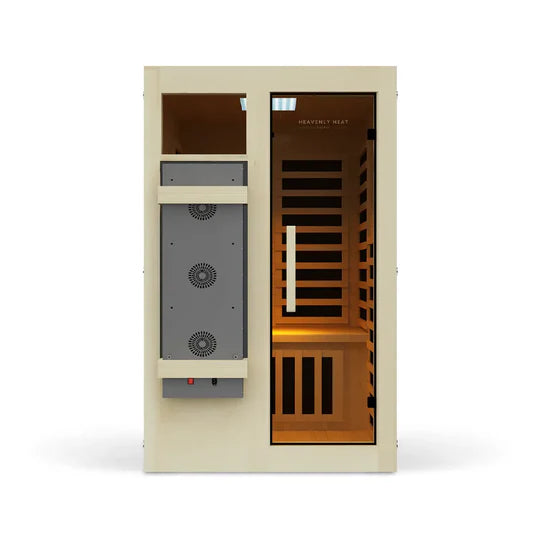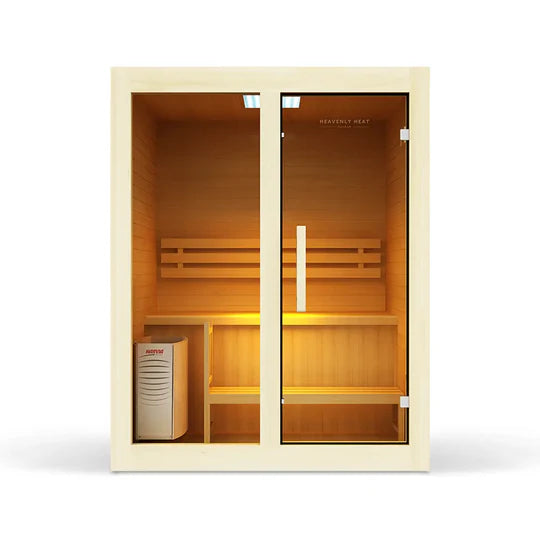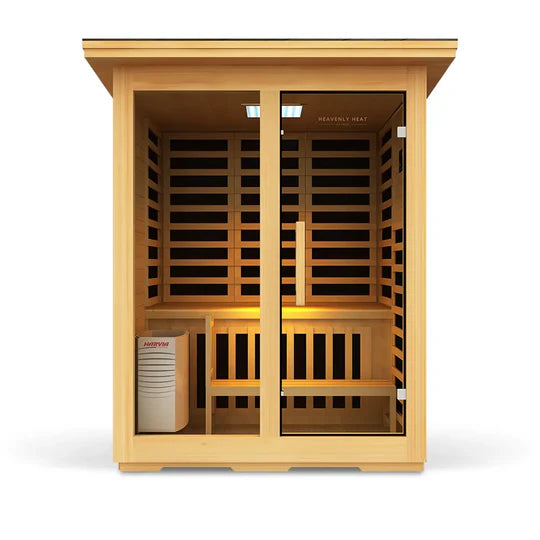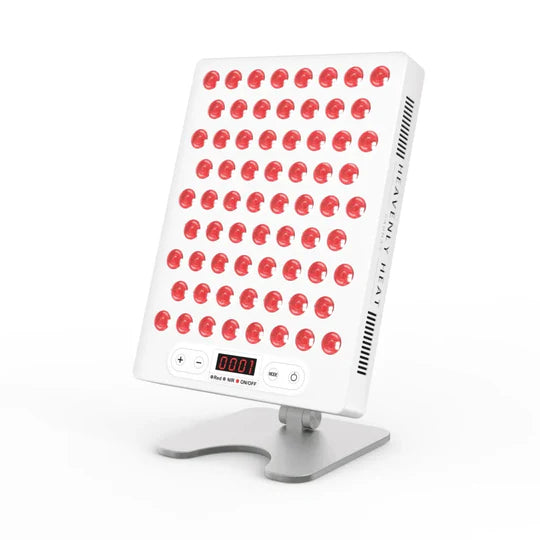Sauna Meditation Techniques: Practicing Mindfulness in Heat

Feeling stressed and unable to fully relax during your sauna sessions? Without the right techniques, you might miss out on the true benefits of heat therapy, leaving you more tense than rejuvenated.
Sauna meditation techniques combine mindfulness and relaxation to help you unwind, find calm, and make the most of your heat therapy sessions.
Table of contents
Key Takeaways
Sauna Meditation Enhances Relaxation: Heat therapy loosens muscles, slows breathing, and promotes mindfulness.
Safety Comes First: Stay hydrated, start with short sessions, and listen to your body.
Choose the Right Sauna: Infrared saunas offer gentle heat, while traditional and steam saunas create a more intense experience.
Use Simple Meditation Techniques: Deep breathing, visualization, and guided meditation can deepen relaxation.
Aromatherapy Boosts the Experience: Essential oils like lavender and eucalyptus enhance relaxation and breathing.
- Cool Down and Reflect: Gradually exit the sauna, hydrate, and take time to process your experience.
What Is Sauna Meditation and How Does It Work?
- Sauna meditation works because heat helps you slow down: The heat in a sauna naturally calms your body, your muscles loosen, and your breath slows. This makes it much easier to focus and stay present during meditation.
- People have used heat and stillness together for centuries: From Finland’s sauna rituals to Japan’s onsen culture, people have been combining quiet time and heat for generations to relax their minds and heal their bodies.
- It’s easy to get started, even if you’re new to this: You don’t need to be an expert. Start with just 10 to 15 minutes and give your body time to adjust to the heat. You can slowly increase the time as you get used to it.
- The warmth helps your body let go of stress: As you sit in the heat, your body begins to sweat and your blood starts flowing better. This helps release built-up tension, physically and mentally.
- The heat makes it easier to stop overthinking: There’s something about the sauna that feels like it wraps around you. It gently pushes away all the noise and stress from the day and helps you just be.
- After 30 minutes, your body and mind feel like new: Once you're used to it, you can go for longer sessions, up to 30 minutes. You come out feeling lighter, clearer, and refreshed from the inside out.
Is It Safe to Meditate in a Sauna?
- Drinking water before and after makes sauna meditation safer: The heat in a sauna can quickly lead to dehydration. That’s why it’s important to drink water before you begin and again after you finish meditating.
- Starting with short sessions helps your body adjust: Your body needs time to get used to the heat. Begin with short meditation periods and slowly increase the time only if you feel comfortable.
- Feeling dizzy or lightheaded is a sign to step out immediately: If at any point during your meditation you start to feel unwell, it’s your body’s way of telling you to leave the sauna right away.
- People with heart or blood pressure problems should be extra careful: If you have any heart condition or low blood pressure, always check with your doctor before trying sauna meditation. The heat may not be safe for you.
- Sitting comfortably and keeping the sauna at a safe temperature prevents overheating: Choose a comfortable place to sit and avoid cranking the temperature too high. A moderate heat level makes the experience safer and more enjoyable.
- Staying too long can make you tired and unfocused: Meditating in a sauna for more than 30 minutes can lead to heat exhaustion or loss of concentration. It’s best to keep your session short and mindful.
- Being aware of your limits makes sauna meditation truly relaxing: When you meditate in the sauna with awareness and care, it becomes a powerful way to calm your mind and relax your body safely.
| ✅ Do’s |
❌ Don’ts |
| Hydrate before and after |
Enter the sauna dehydrated |
| Start with short sessions |
Stay too long (beyond 30 min) |
| Listen to your body |
Ignore dizziness or discomfort |
| Use comfortable seating |
Sit in an uncomfortable position |
| Choose a moderate temperature |
Overheat your body |

How to Choose the Best Sauna for Meditation
Select the Right Sauna Type
Consider the sauna type that best suits your needs . Infrared saunas offer a gentle heat , making it easier to focus.
Traditional saunas create a more intense experience , while steam saunas add moisture, enhancing relaxation .
Dry saunas provide a hotter, arid environment . Also, decide whether you prefer an indoor or outdoor setup and if portability is a factor .
Consider Temperature and Humidity Levels
A sauna temperature range of 120-150°F (49-66°C) works well for meditation. Infrared saunas provide milder heat, while traditional ones generate more intensity.
Higher humidity can make breathing more difficult, while dry heat may feel more comfortable for longer sessions. Adjusting these settings ensures a peaceful experience.
Opt for Comfortable Seating
Good posture is essential for effective meditation. Look for ergonomic sauna seats or cushioned backrests. If your sauna lacks built-in comfort, consider adding a cushion or mat to prevent discomfort.
Choose a Quiet and Private Space
A peaceful setting enhances meditation. If using a public sauna, take steps to block out distractions, such as earplugs or soundproofing. Privacy helps create a calming atmosphere, allowing you to disconnect and focus.
Prioritize Safety Features
Safety is key for sauna meditation. Choose a sauna with automatic temperature control, proper ventilation, and well-grounded electrical systems to prevent hazards. These features help maintain a safe and stable environment.
Look for Customizable Lighting and Aromatherapy Options
Adjustable lighting and aromatherapy can enhance your meditation. Soft lighting sets a calming tone, while essential oils like lavender or eucalyptus promote relaxation. Some saunas come with built-in diffusers , making it easier to create a soothing environment.

Check for Sufficient Space
Ensure your sauna has enough room for comfortable movement and any accessories like cushions.
A cramped space can make long sessions uncomfortable, while too much space may feel impersonal.
Simple Meditation Techniques for the Sauna
Deep Breathing for Relaxation
Slow, controlled breaths activate the body's relaxation response, reducing stress. Inhale deeply through your nose, hold for a moment, and exhale slowly through your mouth. This technique helps you stay grounded and calm.
Guided Meditation for Mindfulness
Listening to a guided meditation can help you stay present. A soothing voice or recording leads you through a journey, shifting focus away from discomfort and promoting emotional balance.
Visualization Techniques for Inner Calm
Imagining a peaceful setting, like a beach or forest, can transport your mind away from the heat. Visualization reduces stress and encourages a sense of inner peace.
Mantra Meditation for Focus
Repeating a calming word or phrase, such as “peace” or “breathe,” can clear your mind.
This technique helps prevent distractions and promotes relaxation.
Body Scan Meditation for Tension Release
Starting at your feet and moving upward, mentally check in with each body part. Consciously relaxing areas of tension helps deepen relaxation.
Breath Control for Enhanced Heat Tolerance
Practicing controlled breathing techniques like diaphragmatic breathing can help regulate body temperature and reduce anxiety in the sauna.
Progressive Muscle Relaxation in the Sauna
Tense and relax different muscle groups, starting from your feet and working upward.
The sauna’s heat enhances this technique, loosening muscles and encouraging relaxation.
Step-by-Step Guide to Meditating in a Sauna
Prepare Your Mind and Body for Sauna Meditation
Before entering the sauna, set an intention, whether for relaxation, clarity, or emotional release. Hydrate well, as sweating will cause fluid loss. Gentle stretching can improve circulation and help you relax once inside.
Create a Comfortable and Relaxing Sauna Environment
Adjust the sauna’s temperature and humidity to a comfortable level. Dim lighting or candlelight can enhance relaxation, while essential oils like lavender or eucalyptus create a calming atmosphere. Soft background music or nature sounds can also improve focus.
Focus on Deep Breathing for Maximum Relaxation
Deep, slow breaths help activate the body’s relaxation response. Try methods like the 4-7-8 technique (inhale for four seconds, hold for seven, and exhale for eight) to deepen relaxation and slow your heart rate.
Practice Mindfulness to Enhance Your Meditation Experience
- Mindfulness starts by being kind to yourself: “Mindfulness is inherently an act of self-care and compassion, encouraging individuals to cultivate a sense of friendliness toward themselves,” says Dr. Jon Kabat-Zinn , a renowned scientist and meditation teacher who pioneered the Mindfulness-Based Stress Reduction program.
- Being present in the sauna helps your body and mind relax: This perspective highlights the essence of sauna meditation, where staying present becomes a gentle act of nurturing both mind and body.
- Paying attention to heat and breath keeps you in the moment: Focus on the sensations around you, the warmth caressing your skin, the steady rhythm of your breath, and the stillness of the sauna.
- Letting go of tension becomes easier when you stay aware: As the heat softens physical tension, let your awareness anchor you in the moment. If your thoughts wander, simply guide them back with kindness, embracing the process as a way to deepen relaxation and self-connection.
Use Guided Visualization to Deepen Your Meditation
- Visualization helps your mind settle down faster: Guided visualization lets your thoughts slow down by giving your mind something peaceful to focus on, like a quiet beach or a forest.
- Thinking of nature makes the sauna feel more relaxing: When you imagine warm sunshine and calm places while you're in the sauna, it feels even more soothing, like your stress is melting away.
- Listening to a guide or imagining your own scenes both work well: Whether you're following an audio guide or creating your own mental images, both help keep your mind from wandering and deepen your meditation.
- Using your senses makes your meditation feel more real: If you imagine the sound of waves, the feel of a breeze, or the smell of fresh air, your meditation becomes more powerful and calming.
Incorporate Gentle Movements for a Full-Body Connection
- Moving your shoulders and neck helps your whole body relax: Gentle stretches like rolling your shoulders or tilting your neck can release tension, making your body feel lighter and more at ease in the sauna.
- A slow sway keeps your mind from drifting: When you gently sway side to side, it’s easier to stay present and not get lost in thoughts. The motion keeps your body and mind working together.
- Breathing with your movements makes the experience more powerful: Syncing your breath with simple actions, like lifting your arms when you breathe in and lowering them as you breathe out, can deepen your focus and calm your system.
- Pressing your feet into the floor helps you feel more connected: Grounding through your feet gives you a solid, balanced feeling. It brings your awareness to your whole body and helps you feel steady while you meditate.
Cool Down and Reflect After Your Sauna Meditation
- Step out slowly to help your body adjust: Cooling down is essential after sauna meditation. Sudden temperature shifts can shock the body, so step out gradually and allow your body to adjust.
- Take deep breaths in a quiet, cool space: Sit quietly and breathe slowly to help your mind and body relax after your sauna meditation.
- Write down your thoughts to see your progress: Journaling your feelings and reflections can help you notice changes over time.
- Drink water or herbal tea to stay hydrated: Replenish fluids lost in the sauna by drinking water or herbal tea.
- Cooling down helps you feel calm and refreshed: Taking time to cool down properly after sauna meditation helps balance your emotions and clears your mind.
How Long Should You Meditate in a Sauna?
- Beginners should meditate 5 to 10 minutes in the sauna: Starting with shorter sessions helps your body get used to the heat and meditation combined.
- Experienced meditators can stay 15 to 20 minutes safely: You can extend your sauna meditation time once your body adapts but avoid overheating.
- Longer meditation sessions improve focus and mental clarity: Meditating for 40 minutes or more Research shows benefits for concentration and clear thinking.
- Short sessions help calm the mind and improve focus: Even 10 minutes of meditation brings a sense of calm and better attention.
- Combining heat with breathing boosts relaxation and focus: Using mindful breathing and visualization with sauna heat makes meditation more effective, even in short sessions.

What Happens to Your Body and Mind During Sauna Meditation?
- Your blood flows better when you sit in sauna heat: The heat from the sauna opens up your blood vessels and helps more oxygen travel through your body.
- The warmth makes your body release feel-good chemicals: Being in the sauna triggers endorphins and serotonin, which naturally help you feel calmer and happier.
- This deep relaxation helps you sleep more peacefully: The calming effects from the sauna help your mind unwind, making it easier to fall asleep and wake up refreshed.
- Meditation gives your body and mind extra support: Meditation is proven to lower stress and improve how your body responds to pressure, both mentally and physically.
- Studies show meditation has strong benefits over time: Research found that meditation can improve behavior, lower stress, and help the body respond better to challenges.
- Young people also feel better with regular meditation: Even though studies in youth are fewer, they still show that meditation helps with emotions and reduces stress, just like in adults.
- Doing meditation in the sauna makes both work better: When you combine heat with meditation, you can feel even more relaxed, focused, and mentally clear.
- A regular sauna meditation routine can change how you feel: Mama Tenny, a YouTuber, shared that doing sauna meditation for a year helped her feel deeply relaxed and more present.
- Deep breathing and imagination make the effect even stronger: She adds breathing techniques and mental images to her sauna sessions, which helps her focus and relax even more.
- Listening to your body is key for safe sauna meditation: To enjoy the full benefit, start slow, drink water, and notice how your body feels during each session.
How Aromatherapy Can Enhance Sauna Meditation
Deepens Relaxation
Aromatherapy enhances sauna meditation by promoting relaxation. Essential oils like lavender and chamomile calm the nervous system, while sauna heat helps the body absorb their benefits more effectively.
Enhances Breathing
- Breathing feels easier when essential oils are used: Aromatherapy helps you breathe more deeply and smoothly during a sauna session. Oils like eucalyptus and peppermint clear blocked noses and open your airways, making each breath feel cool and refreshing.
- Warm steam helps the oils reach your lungs better: The heat and steam inside the sauna carry essential oil particles deeper into your lungs. This makes their effect stronger and helps your body absorb their benefits faster.
- People with allergies or blocked noses get big relief: If you struggle with breathing issues or allergies, this mix of steam and essential oils can really help. It loosens congestion and soothes irritated airways.
- Every breath brings a little more strength to your lungs: With every inhale, these oils gently support your lungs, helping you take in more oxygen and improve your overall breathing health.
Strengthens Mind-Body Connection
- Aromatherapy makes the mind and body work better together: Meditation already helps connect your thoughts and body sensations. Adding aromatherapy strengthens that bond, making the whole experience more powerful and focused.
- Some scents wake up your brain and help you stay present: Essential oils like rosemary and clary sage can boost your mental alertness. They help you pay more attention to each breath and body sensation while meditating.
- Smells can help you relax and let go of stress: Certain scents trigger emotional responses. This helps you feel calm, let go of tension, and ease into a peaceful state more easily during meditation.
- Science supports the mental health benefits of aromatherapy: Research shows that aromatherapy can improve your mental well-being. It’s been found to help with depression, anxiety, and other mood issues.
- Natural plant oils work by affecting how you feel: Essential oils come from flowers, leaves, bark, and roots. Their natural compounds can improve your mood and physical comfort when you smell them or apply them to your skin.
- Aromatherapy also helps with physical pain and sleep: Using the right scents can ease headaches, sore muscles, and even help you sleep better. This makes sauna meditation more healing for the body too.
- A healthy lifestyle makes aromatherapy even more effective: For best results, pair aromatherapy with good nutrition and expert advice. This makes sure you're using the oils safely and getting the most benefits.
- Sauna meditation becomes a peaceful escape with scents: When you mix heat, mindfulness, and calming scents, you create a space for deep balance. It helps you feel lighter, clearer, and more connected to yourself.
Boosts Circulation and Detoxification
Sweating is a natural detoxification process. Sauna heat opens pores and increases circulation, helping the body eliminate toxins.
Using essential oils like lemon and juniper can further enhance this detoxifying effect.
Elevates Mood and Mental Clarity
Aromatherapy stimulates the brain’s limbic system, which controls emotions and mood. Using specific scents, such as citrus for energy or lavender for relaxation, can shape your meditation experience and enhance emotional balance.
Creates a Personalized Meditation Experience
Aromatherapy allows you to tailor your meditation to your specific needs. Over time, your brain associates certain scents with relaxation, strengthening your practice.
Choose essential oils that align with your meditation goals, such as lavender for stress relief or sandalwood for focus.
Supports Skin and Respiratory Health
Essential oils like eucalyptus and peppermint help clear nasal congestion and open airways, making breathing easier in a sauna. The heat also opens pores, allowing oils to penetrate deeper and hydrate the skin.
Tips for Staying Comfortable While Meditating in a Sauna
Choose the Right Sauna Temperature
For comfortable meditation, set your sauna temperature between 110°F and 150°F (43°C - 65°C).
Beginners should start at a lower temperature and increase gradually. Infrared saunas operate at lower temperatures and may be more comfortable for longer meditation sessions. If you ever feel dizzy, step out and cool down.
Wear Light and Breathable Clothing
- Light and airy clothes help you stay cool: Wearing loose and breathable fabrics like cotton or linen keeps your body from overheating and helps sweat dry faster, making your meditation more comfortable.
- Synthetic clothes make you feel hotter: Materials like polyester trap heat and sweat, which can make sitting in the sauna feel sticky and uncomfortable.
- You don’t need fancy gym wear for short sessions: Moisture-wicking gear can help in longer sessions, but it’s not a must if you’re only meditating for a short while.
- Tight or thick clothes can ruin your focus: Heavy or tight clothing can make you feel too warm and distract you from your meditation, making it hard to relax.
- A towel wrap works just as well: If you prefer wearing less, simply wrapping a towel around your body keeps things simple and cool.
- What you wear should help your body stay balanced: The main goal is to choose clothes that let your body handle the heat naturally so you can stay calm and focused.
Maintain Proper Hydration Levels
Hydration is essential before, during, and after sauna meditation. Drink at least 16 ounces (500 ml) of water before your session to prevent dehydration. If you feel thirsty while meditating, take small sips of water.
Use Comfortable Seating or Cushioning
- Sitting on something soft makes meditation easier: Wooden sauna benches can be hard, so using a towel, cushion, or sauna mat helps give your body extra support.
- Using natural materials keeps you cooler: Cushions made from cotton or linen don’t trap heat, so they keep you more comfortable in the sauna.
- A folded towel still makes the bench softer: If you like sitting directly on the bench, folding a towel can add some comfort without blocking heat.
- Comfortable seating helps you sit up straight and relax: Good support keeps your posture right and stops discomfort, so you can focus on breathing and relaxing.
Practice Controlled Breathing Techniques
Deep breathing techniques enhance relaxation and prevent dizziness in a sauna. Box breathing (inhale for 4 seconds, hold for 4, exhale for 4, hold for 4) can help regulate your heart rate and keep you calm.
Adjust Meditation Duration Gradually
Start with short meditation sessions and slowly build up as your body adapts to the heat. Beginners should begin with 5-10 minutes and gradually extend to 20 minutes if comfortable.
Meditating for too long can lead to overheating, dehydration, or lightheadedness. If you start feeling uncomfortable, shorten your session or take breaks.
Your body needs time to adjust to the combination of heat and stillness, so listen to its signals and increase your duration only when it feels natural.
Incorporate Gentle Stretching Before and After
Stretching before and after meditation enhances relaxation and flexibility. Yoga poses like child’s pose or butterfly stretch can help release tension and deepen your meditation practice.
How Often Should You Meditate in a Sauna?
If you’re new to sauna meditation, start with two to three sessions per week to see how your body responds.
Daily meditation is safe for most people, but be mindful of dehydration or fatigue.
FAQs
Can I combine sauna meditation with other wellness practices, like yoga or massage therapy?
Sauna meditation complements wellness practices like yoga, massage, and breathwork, enhancing relaxation and balance. Meditating in the sauna after yoga can improve flexibility and calm the mind. Before a massage, it warms up muscles for greater effectiveness, and afterward, it extends relaxation and relieves tension. Breathwork in the sauna deepens focus and improves oxygen flow. Adding essential oils like lavender or eucalyptus can further enhance the calming effects. These combinations make sauna meditation a valuable tool for mind and body wellness.
How can I maintain mindfulness during a sauna meditation if the heat feels overwhelming?
Meditating in a sauna can be intense, but staying mindful is possible. When distracted by the heat, refocus on your breath. Deep, slow breathing helps you stay calm and prevents panic. If the warmth feels overwhelming, visualize a cool breeze or flowing river to create mental balance. Feeling anxious? Accept the sensation without resistance and remind yourself that you are safe. However, listen to your body. If you feel dizzy or extremely uncomfortable, it is time to step out. Mindfulness is about awareness, not endurance.
What are the benefits of sauna meditation for people with chronic pain or muscle stiffness?
Sauna meditation can ease chronic pain and loosen stiff muscles. The heat relaxes tense muscles, improves flexibility, and enhances blood circulation, delivering oxygen and nutrients to sore areas and reducing inflammation. This combination accelerates healing and relieves pain. Meditation calms the nervous system, making pain more manageable. After workouts, sauna meditation supports recovery by flushing toxins and reducing soreness, leaving you refreshed.
Are there aerospecific bath therapy oils I should avoid when meditating in a sauna?
Some essential oils can be harmful in a sauna, so it's important to choose carefully. Oils like cinnamon and clove may cause skin irritation or breathing discomfort due to their spicy nature. Strong menthol compounds in eucalyptus and peppermint can also feel overpowering in high heat, disrupting relaxation. Citrus oils, such as lemon and bergamot, may degrade in heat and release harmful compounds. Additionally, essential oils can trigger allergic reactions, so testing is recommended. Selecting the right oils helps create a safe and calming meditation experience.


